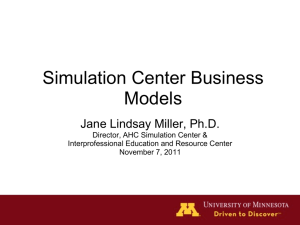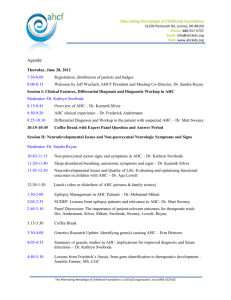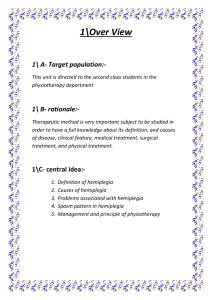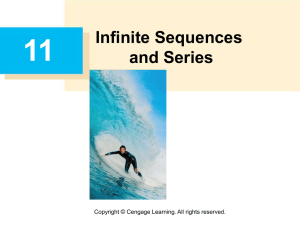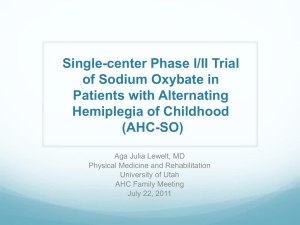Dr Ken Silver - International Foundation for Alternating Hemiplegia
advertisement
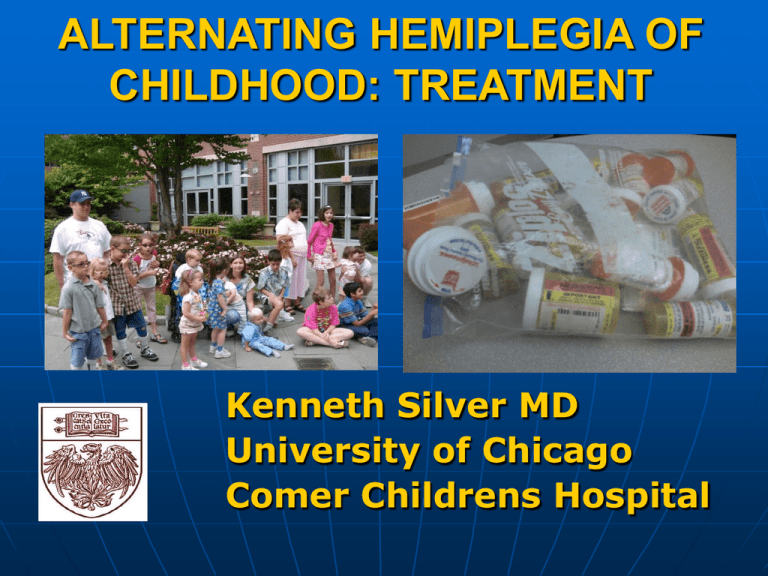
ALTERNATING HEMIPLEGIA OF CHILDHOOD: TREATMENT Kenneth Silver MD University of Chicago Comer Childrens Hospital AHC: Treatment Pathophysiology unknown Medication Trials Anti-epileptic Anti-migraine Movement Disorders Flunarizine most effective med but not sufficient FLUNARIZINE Non selective blocker of voltage dependant Calcium and Sodium Channels Attenuates amplitude of spontaneous post-synaptic currents in cortical pyramidal cells Reduces firing frequency in high extracellular Potassium Alternating Hemiplegia of Childhood: Treatment M. Mikati et al Pediatric Neurology (2000) 23 27/44 patients on FLU 21 Favorable response (78 %) 100% decrease duration 86% decrease frequency One patient attack free Two patients exacerbation after D/C 2/7 responded to Verapamil Use or effectivness of FLU not correlated with developmental outcome Alternating Hemiplegia of Childhood: Treatment M. Sasaki, N. Sakuagawa, M. Osawa Brain & Development (2001) 23 106 of 201 Japanese Child Neurologist responded to questionnaire 28 AHC patients seen, All received Flunarizine Dose 5-15 mg 18 showed positive response 7 decrease duration, 5 decrease frequency 6 relapse after withdrawal 2 responded to Amantadine Subsequent report K. Sone Neuropediatrics 2000 31 Improvement with Amantadine not sustained AHC: Treatment N=103 Pediatrics 2009;123:e534–e541 AHC: Flunarizine Treatment N=80 60 60 50 40 37.5 30 % positive % negative 20 % no change 10 2.5 0 % positive % no change Benzodiazepines N= 55 59 60 50 40 38 % positive 30 % negative 20 % no change 10 3 0 % positive % no change Diazepam N=34 70 60 50 40 30 20 10 0 -10 78 80 65 60 40 % positive 26 % negative % no change 20 18 0 -9 % positive 80 Clonazepam N=28 -4 -20 % no change % positive Lorazepam N=25 % no change 80 60 40 % positive 20 % negative 12 0 % no change -8 -20 % positive % no change Benzodiazepines Phenobarbital N=42 Valproic Acid N=42 78 80 100 83 80 60 40 20 % positive 40 % negative 20 % no change 10 0 60 -7 -20 % positive % negative % no change 3 -20 % positive Phenytoin N=29 83 60 40 20 10 0 -10 -7 -20 % no change % no change 80 % positive 40 0 100 87 60 20 -10 % positive Carbamazepine N=39 80 0 -20 % no change 100 12 % positive % no change AHC: Other Anticonvulsant Treatment N=81 80 74 60 40 % positive 20 % negative 0 6 -20 % no change -20 % positive % no change Anti-migraine N=23 Chloral Hydrate N=19 100 84 80 60 % negative 11 0 % no change -5 -20 % positive 91 80 % positive 40 20 100 60 40 20 9 0 % no change 0 % % no positive change Extra-pyramidal Med N=31 Psychotropic Med N=36 80 100 84 80 60 20 60 % positive 40 % negative % no change 10 0 -6 40 20 19 0 -14 -20 -20 % 67 % no % positive % no change AHC: Treatment Pathophysiology unknown Medication Trials Anti-epileptic Anti-migraine Movement Disorder: Paroxysmal Dyskinesia Channelopathy Flunarizine most effective med but not sufficient Familial Hemiplegic Migraine FHM1 2 1 Ca2+ channel structure Ca2+ channel structure Familial hemiplegic migraine: Severe, autosomal dominant, associated with reversible weakness Other associations: progressive cerebellar ataxia, coma, neuromuscular junction defect Molecular pathogenesis: or current density left-shifted activation threshold Familial hemiplegic migraine: mouse knock-in model Cortical spreading depression van den Maagdenberg et al, 2004 Alternating Hemiplegia of Childhood: Pathophysiology Channelopathy: Ion channels responsible for generating signals between excitable membranes Heterogeneous protein complexes with selective ion permeability (Na, K, Ca, Cl) Channels are gated by changes in transmembrane potential and ligands Several paroxysmal neurological disorders known,eg. Periodic paralysis, episodic ataxia, frontal epilepsy, Hemiplegic migraine: FHM1:-CACNA1A, FHM2:-ATP1A2 Alternating Hemiplegia of Childhood: Pathophysiology Channelopathy: Paroxysmal features, episodic, unpredictable from a stable baseline Therapeutic Flunarizine is channel blocker Mutations demonstrated in known channel genes such as those seen in FHM Alternating Hemiplegia of Childhood: Pathophysiology Cortical Speading Depression EEG contralateral slow waves Neuroimaging and Neuropathology do not show any structural abnormalities Fluctuating Hemiplegia Depolarization of neuronal region stimulated by increased K or glutamate Spread of depolarization at 2-4 mm/min Long lasting neuronal depression Responsible for aura in migraine Alternating Hemiplegia of Childhood: Pathophysiology Cortical Spreading Depression: FHM1 mutant presynaptic voltage gated Ca channels open to small membrane depolarizations Neuronal excitability is increased with more influx of Ca, release of glutamate and K FHM2: extracellular K builds up because mutant Na/K ATPase cannot bind K and exchange for Na results in increase glutamate ATP required to maintain neuronal membrane potential and used up to quickly ALTERNATING HEMIPLEGIA OF CHILDHOOD From peas to pores

